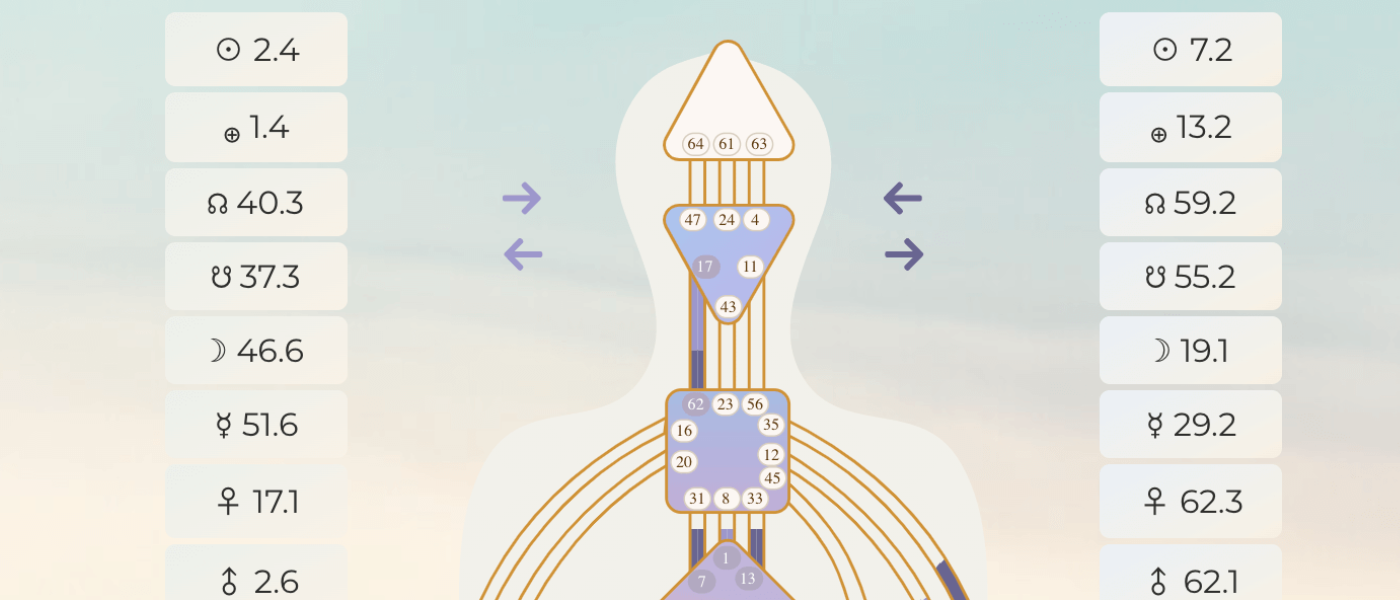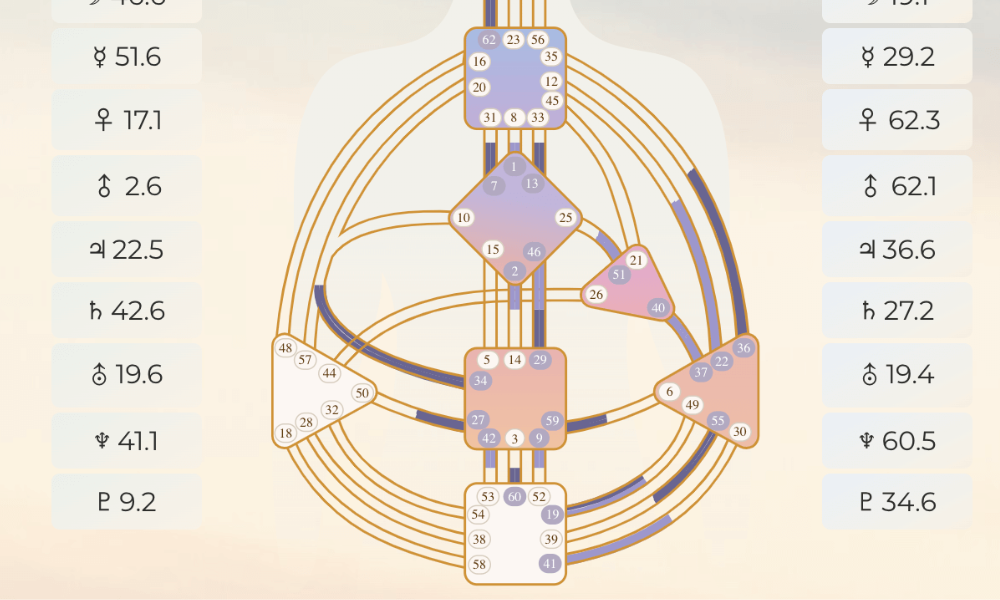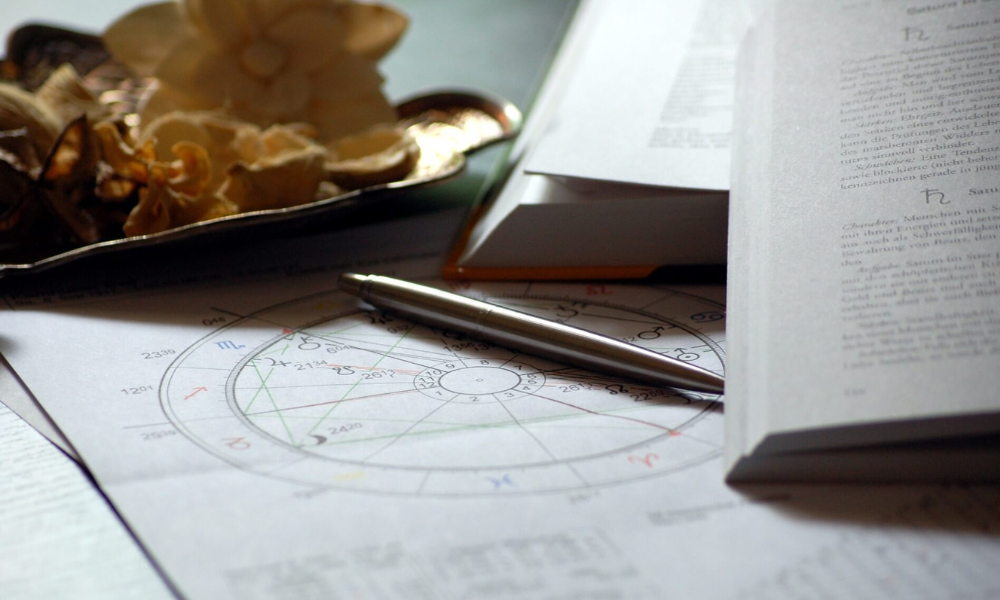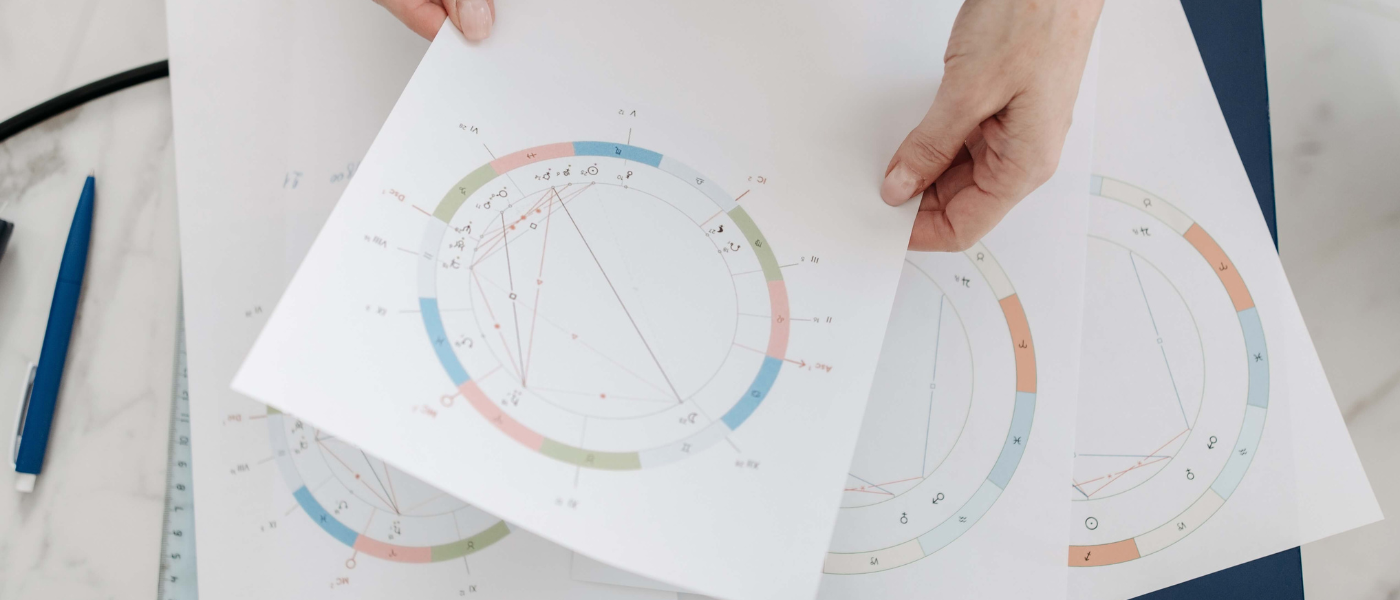what is human design?

Human Design is a system of personality analysis and self-discovery that combines elements of astrology, the I Ching, the Kabbalah, and the energy centers/Chakra system.
It was developed by a man named Alan Robert Krakower, otherwise known as Ra Uru Hu, in 1987.
The core idea behind Human Design is that each person is born with a unique design or blueprint that determines their personality traits, strengths, weaknesses, and purpose in life.
Your birth date, time and location are analysed to create your own unique Human Design Chart.
Key Takeaways
- Human Design is based on the idea that each person has a unique energetic blueprint, which is determined by the positions of the planets and stars at the time of their birth.
- There are five main Human Design Types: Manifestor, Generator, Manifesting Generator, Projector, and Reflector. Each type has its own unique strategy for making decisions and living in alignment with their energy.
- The Human Design chart is made up of nine energy centers, which correspond to different aspects of our physical, emotional, and spiritual being. The presence or absence of energy in each center can reveal strengths, challenges, and tendencies in a person’s personality and behavior.
- Human Design can be used as a tool for self-discovery, personal growth, and decision-making. By understanding their Human Design chart, individuals can gain insights into their unique strengths, challenges, and life purpose, and make choices that align with their authentic selves.
What is Human Design, and how does it work?
The Human Design system is a new age practice that assigns individuals to one of four different types, each with its own unique characteristics: Manifestor, Generator, Manifesting Generator, Projector, and Reflector.
The system also uses a person’s birth data, including birth time, to calculate their “body graph,” which visually represents their unique design.
The body graph consists of nine centers, each corresponding to different aspects of the self, including emotions, intuition, and communication.
Also Read>>> Human Design Types
Human Design is used as a tool for self-awareness and personal growth. It can help individuals better understand their strengths and weaknesses, make decisions that align with their true nature, and navigate relationships more effectively.
Some people also use Human Design to gain insight into their life purpose and how to fulfill it.
The History of Human Design
Human Design emerged over 30 years ago when its founder, Ra Uru Hu, had a profound encounter with a “Voice” that lasted for eight days. During this experience, he received information that formed the blueprint for the Human Design concept.
The principles of Human Design draw from a range of sources, including Western Astrology, Chakras, Quantum Physics, Kabbalah, and I Ching.
We may notice some aspects from these pre-existing practices as we delve deeper into Human Design.
Ra Uru Hu’s students have since become teachers of Human Design worldwide, spreading their knowledge and encouraging others to experiment with their own designs.

The 5 Personality Types In Human Design
The five energy types in Human Design include Manifestor, Generator, Manifesting Generator, Projector, and Reflector.
Each type is associated with a specific productivity period, a strategy for utilizing opportunities, a signature indicating they are living by their human design, and a not-self theme representing the feeling when not in tune with their energy type.
Manifestor
Manifestors make up around 9% of the population and are natural initiators. Their strategy is to inform those around them of their choices and decisions before taking action.
Due to their powerful impact, their closed-off aura may cause others to feel off balance and try to control them.
However, when Manifestors share their plans, it puts those around them at ease and removes energetic resistance. Feeling at peace is the signature indicating they are following their Human Design.
If they move through life without informing others, they may experience resistance and experience anger; this is the theme of their not-self lifestyle.
Generator
Around 70% of the population are Generators; these people are the life force of the planet. Generators have a defined sacral center and an open, inviting aura that naturally draws life toward them.
Their strategy is to respond instead of initiate opportunities, but they must follow their excitement.
A generator will shine if they are doing something they are passionate about but equally will wilt if they are doing something they don’t like.
Therefore, it’s important for a generator to say no to opportunities that they don’t want. They will feel satisfied when they are on the right Human Design path and frustrated when they’re not.
Manifesting Generator
Manifesting Generators possess a blend of Manifestor and Generator energy, allowing them to excel at multitasking.
They must embrace the fact that each day will be different from the last; they shouldn’t expect consistent energy.
It’s important to note that their productivity and motivation levels may vary daily but can always be restored through adequate sleep.

A manifesting generator strategy is to respond, listen to their gut instinct, and determine whether to proceed.
The main difference between this type and a generator is that they have to inform in the same way a manifestor does, but only after they have responded to the opportunity. It’s essential to follow this sequence.
Manifesting Generators feel content and fulfilled when living according to their design. However, if they take on projects or work they dislike, they will experience frustration and anger.
Projector
A projector strategy is to wait for recognition and an invitation; they make up about 20% of the population.
They possess a focused and penetrating aura that enables them to see deeply into others. When acknowledged and invited, Projectors can serve as invaluable guides.
However, their openness makes them susceptible to conditioning, other people’s energy, and the outside world.
These can result in exhaustion and bitterness if they focus their energy on the wrong people or are not adequately recognized.
Projectors must learn to be discerning about where they direct their energy. They have a natural talent for mastering systems, and when they use their energy correctly, they can achieve success in their life and relationships.
Reflector
Reflectors comprise only 1% of the population and are identified by having all their centers open.
They possess a resilient aura that samples and reflects energies around them. Unlike other types, Reflectors have a unique way of processing experience since their chemistry magnifies everything and everyone.
This attribute allows them to see what’s happening in a way that nobody else can.
Their greatest strength is in their capacity to read others and their surroundings. Reflectors can experience the wonder and surprise of life when healthy and in the right place.
However, if they end up identifying with what they are reflecting, they may become exhausted and disappointed.
How does a Human Design chart work?

A Human Design chart is a graphical representation of an individual’s unique design, based on their birth information (date, time, and place of birth).
It is composed of nine energy centers, which correspond to specific aspects of life, and 64 hexagrams, which represent the various channels and gates of energy flow between these centers.
The chart also shows the individual’s Energy Type, Authority, Profile, and Incarnation Cross, which provide insights into their personality traits, decision-making style, life purpose, and more.
Where can I get my Human Design chart?
Several websites offer free Human Design chart calculators that are popular with people just getting started. You will be asked to provide your birth date, time, and location.
Once you have your chart, you can begin exploring and learning about your unique human design.
It is important to note that while these calculators can provide a good starting point, it may be worth consulting a trained Human Design practitioner to gain a deeper understanding of your chart and how to apply it to your life.
What are the centers on a Human Design chart?
The Human Design chart is made up of nine energy centers, which correspond to different aspects of our physical, emotional, and spiritual being.
The presence or absence of energy in each center can reveal strengths, challenges, and tendencies in a person’s personality and behavior.
On a chart, if a center is white it is open or undefined, and if it is colored it is defined or closed.
Below is a list of all nine energy centers.
- Head Center
- Mind Center
- Throat Center
- G Center
- Heart Center
- Sacral Center
- Splenic Center
- Solar Plexus Center
- Root Center
What are the eight inner authority types in a human design chart?
In Human Design, the Inner Authority refers to the decision-making process that is unique to each individual, based on their body graph and design.
There are eight Inner Authority types in Human Design, each with its own decision-making process.
Emotional authority
This type of Inner Authority is based on feeling and requires time to make decisions. Emotionally defined people must wait for their emotional wave to reach clarity before making important decisions.
Sacral Authority
Sacral Authority is based on gut feeling and is unique to Generators and Manifesting Generators. People with Sacral Authority must listen to the body’s response and wait for a clear “yes” or “no” before making decisions.
Splenic Authority
This type of Inner Authority is unique to those with a defined spleen center and is based on instinct. People with Splenic Authority must trust their intuition and make decisions in the moment.
Self-projected Authority
Self-projected authority is based on the projection of energy from the throat center. People with Self-Projected Authority must speak out loud about their decision and listen to how it feels.
Ego Authority
This type of Inner Authority is based on the ego or heart center. People with Ego Authority must trust their inner voice and make decisions that align with their sense of self.
Mental Authority
Mental Authority is based on the Ajna (mind) center and requires mental clarity to make decisions. People with Mental Authority must clearly understand the pros and cons before making a decision.
Lunar Authority
The Lunar Cycle Authority is based on the phases of the moon and is unique to Reflectors. People with Lunar Authority must wait one full lunar cycle before making decisions.

Environmental/No Inner Authority
Environmental Authority, also known as No Inner Authority, is based on the input from the environment and the people around them.
People with Environmental Authority must wait to make decisions until they have received input from others and the environment.
Also read >>> Sacral Chakra Affirmations
Is there an easy way to read my Human Design chart?
Reading a Human Design chart is a complex process that can take time and study to fully understand.
If you are interested in receiving an in-depth reading, a Human Design expert can help guide you through the process and provide deeper insights into your unique chart.
- Analyze your centers: if a center is white, it is open or undefined, and if it is colored it is defined or closed
- Identify your personality type
- Identify your authority type
- Consider your Profile: Your Profile is determined by two numbers in your chart and represents the way you interact with the world around you.
- Interpret the symbols: Finally, it’s important to interpret the symbols and numbers in your chart in the context of your own unique life experiences and circumstances.

Where does the science come in?
Human Design is not considered a scientifically validated system, and its claims and theories are not supported by empirical evidence or scientific research.
While Human Design incorporates elements from various spiritual and esoteric traditions, it does not rely on empirical observations or the scientific method to develop its theories.
Instead, it is based on the personal experiences and insights of its creator and practitioners.
Although some aspects of Human Design may resonate with scientific ideas, such as the concept of the interconnectedness of all things or the influence of environmental factors on human behavior, these ideas are not unique to Human Design and are not necessarily based on scientific evidence.
What are the strengths and benefits of human design?
Human Design can be a valuable tool for individuals who want to learn more about themselves and their unique strengths, weaknesses, and life purpose.
It encourages self-acceptance by emphasizing the idea that everyone is born with a specific design that is meant to be honored and embraced.
Human Design can also offer guidance for decision-making, something which many people struggle with.
By understanding their type and authority, individuals can make decisions that align with their energy and reduce resistance in their lives.
Finally, Human Design recognizes that rest and self-care are essential for well-being and encourages individuals to prioritize these practices in their lives.
What are the weaknesses of Human Design?
Empirical scientific research does not support human design, making it difficult to evaluate its validity and effectiveness.
While Human Design types can be useful, there is a risk of oversimplifying individuals and reducing them to their type rather than seeing them as complex and unique individuals.
There is a risk that the practice can limit personal agency and freedom by being overly prescriptive in terms of what individuals “should” do or how they “should” live.
Finally, like any tool or system, there is potential for Human Design to be misused or misinterpreted.
This can lead to confusion or harm for individuals who rely on it too heavily. It, like any alternative practice, should always be implemented with awareness.
Important factors to consider working with Human Design
When working with human design, it’s important to consider that it’s just one tool among many. It shouldn’t be used to completely define someone or limit their potential.
It’s also crucial to approach it with an open mind and a willingness to experiment and explore, as not all aspects of Human Design may resonate with everyone.
If you are unsure of your mental place, proceed with caution and remember it is still your own life.
Additionally, it’s essential to understand that it is not a replacement for professional medical or psychological advice and should not be used to diagnose or treat any medical or mental health condition.
Finally, it’s important to approach human design with a sense of curiosity and self-discovery rather than as a prescriptive guide or fixed identity.
Conclusion
In conclusion, Human Design is a unique and insightful system that offers a different perspective on understanding ourselves and our place in the world.
By providing a detailed map of our energetic makeup and guiding us to live in alignment with our true nature, human design can unlock our true potential and lead to a more fulfilling life.
While some may be skeptical of the system, many people have found value in incorporating human design into their lives and using it as a tool for personal growth and self-discovery.
Whether you’re just starting to explore human design or have been practicing it for years, it’s clear this system has much to offer those open to its teachings.



